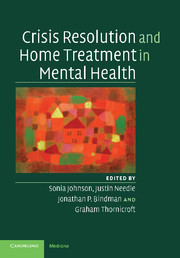Book contents
- Frontmatter
- Contents
- List of contributors
- Foreword
- Acknowledgements
- Section 1 Introduction and concepts
- Section 2 The evidence
- Section 3 Current practice
- 6 Crisis resolution teams: rationale and core model
- 7 The crisis resolution team within the community service system
- 8 Assessment of crises
- 9 Assessment and management of risk
- 10 Symptom management
- 11 Practical psychosocial interventions
- 12 Working with families and social networks
- 13 Strategies for promoting engagement and treatment adherence
- 14 Mixed blessings: service user experience of crisis teams
- 15 Early discharge and joint working between crisis teams and hospital services
- 16 Working with repeat users of crisis resolution services
- 17 Responding to diversity in home treatment
- 18 Coercion and compulsion in crisis resolution teams
- Section 4 Variations and enhancements
- Section 5 Developing a local service
- Index
10 - Symptom management
from Section 3 - Current practice
Published online by Cambridge University Press: 13 August 2009
- Frontmatter
- Contents
- List of contributors
- Foreword
- Acknowledgements
- Section 1 Introduction and concepts
- Section 2 The evidence
- Section 3 Current practice
- 6 Crisis resolution teams: rationale and core model
- 7 The crisis resolution team within the community service system
- 8 Assessment of crises
- 9 Assessment and management of risk
- 10 Symptom management
- 11 Practical psychosocial interventions
- 12 Working with families and social networks
- 13 Strategies for promoting engagement and treatment adherence
- 14 Mixed blessings: service user experience of crisis teams
- 15 Early discharge and joint working between crisis teams and hospital services
- 16 Working with repeat users of crisis resolution services
- 17 Responding to diversity in home treatment
- 18 Coercion and compulsion in crisis resolution teams
- Section 4 Variations and enhancements
- Section 5 Developing a local service
- Index
Summary
Crisis resolution teams (CRTs) are required to address and alleviate the symptoms of the full spectrum of psychiatric disorders. In this chapter, John Hoult discusses the assessment, management and monitoring of symptoms by the multidisciplinary team, including the management of agitated and suicidal patients, and particular considerations relating to prescribing and monitoring medication in crises. The role of psychologists in CRTs and the potential of brief psychological interventions are then described by Fiona Nolan.
The phases of symptom management
Managing symptoms at home with a CRT is in most ways similar to managing symptoms elsewhere, so the similarities will not be mentioned here. Going into the full details of management of specific mental illnesses is beyond the scope of this book, and we assume that teams will be aware of current good practice guidance, such as the NICE guidelines for management of a variety of disorders (http://www.nice.org.uk). Chapter 8 provides a description of how assessment of people in crises differs from assessments elsewhere. In what follows, there will be a brief mention of the assessment phase, but more emphasis will be given to how to plan care and manage people with the more common types of symptom within the CRT.
The planning phase
While the assessment is going on, staff silently wonder what they can do to treat the person at home. Options start to formulate in their minds, changing as information emerges.
- Type
- Chapter
- Information
- Crisis Resolution and Home Treatment in Mental Health , pp. 121 - 136Publisher: Cambridge University PressPrint publication year: 2008
- 1
- Cited by



